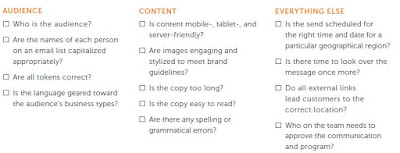By: Lizzy Funk We’ve all done it. No matter how much experience you have in email marketing , it is bound to happen at least o...
By: Lizzy Funk
We’ve all done it. No matter how much experience you have in email marketing, it is bound to happen at least once in your career:
You develop this amazing, compelling, simply breathtaking email that is going to convert oh-so-many people. You hit send and then lean back in your chair with satisfaction, arms crossed and feet up on your desk.
But, then, as your eyes scan your computer screen (so that, of course, you can bask in all the glory that is your email), you see it. You see what you didn’t see the first 100 times you previously read the email back to yourself:
A BIG MISTAKE.
Panic ensues. YOU made a mistake! Noooo!
The emails from recipients start coming in. The phones ring off the hook…cue the horror music! This is surely every marketer’s WORST nightmare (seriously, just typing this out makes me nervous!).
So, my fellow marketers, get ready to feel a little bit uncomfortable as we dive into the various ways emails can go very, very wrong:
There are two ways that you can be proactive in your organization. The first is to create a checklist of everything you need to verify before hitting send. Here is an example of a checklist:
The second is to create an action plan for if and when an email blunder occurs. This plan makes it easier for you to jump into action because it includes a pre-determined notification plan and identifies what role team members are supposed to play. This means that you don’t have to sort all this out while in panic mode. And it saves precious time. As a part of creating your plan, you will want to:
Do you have an email blooper that you’ve recovered from? I’d love to hear about it in the comments section below!
Source
We’ve all done it. No matter how much experience you have in email marketing, it is bound to happen at least once in your career:
You develop this amazing, compelling, simply breathtaking email that is going to convert oh-so-many people. You hit send and then lean back in your chair with satisfaction, arms crossed and feet up on your desk.
But, then, as your eyes scan your computer screen (so that, of course, you can bask in all the glory that is your email), you see it. You see what you didn’t see the first 100 times you previously read the email back to yourself:
A BIG MISTAKE.
Panic ensues. YOU made a mistake! Noooo!
The emails from recipients start coming in. The phones ring off the hook…cue the horror music! This is surely every marketer’s WORST nightmare (seriously, just typing this out makes me nervous!).
So, my fellow marketers, get ready to feel a little bit uncomfortable as we dive into the various ways emails can go very, very wrong:
Incorrect Personalization
In a time when everything is personalized from your thermostat to your watch and of course your email, it is that much more important to ensure your personalization is accurate before you hit the send button. Make sure you have the right token, location, and language ahead of time.Irrelevant Information
As a customer, have you ever received an email and thought, “Does this company have any idea who I actually am?” For example, even though I have been out of college for quite some time (and, no, I’m not telling you how long it has really been), I still get messages from my former bank telling me about how to save money as a student. Irrelevant information can be caused by wrong segmentation and results in consumers receiving an email that has little or nothing to do with their interests or needs.Poor Proofreading
This one sounds obvious—but you would be surprised by the number of emails we all get each day with minor (and even major) proofreading mistakes. Examples of these mistakes include broken links, wrong banners or images, and both spelling and grammar errors. As a rule of thumb, always get a second, third, or even fourth set of eyes on your email before hitting send.Non-Optimal Email Cadence
Another blunder we should all be avoiding is simply sending too many emails. Your audience already has a full inbox; don’t add to it by sending excessive emails. Doing this can lead to unsubscribes or being flagged as spam, totally defeating your goal of getting your subscribers’ (positive) attention.Avoiding Blunders
So how do you avoid these types of blunders? Be proactive.There are two ways that you can be proactive in your organization. The first is to create a checklist of everything you need to verify before hitting send. Here is an example of a checklist:
The second is to create an action plan for if and when an email blunder occurs. This plan makes it easier for you to jump into action because it includes a pre-determined notification plan and identifies what role team members are supposed to play. This means that you don’t have to sort all this out while in panic mode. And it saves precious time. As a part of creating your plan, you will want to:
- Identify stakeholders (who in the organization can help resolve this blunder?)
- Develop a notification plan (who gets notified and when?)
- Plan for different scenarios (have various notification plans based on the severity of the blunder)
Do you have an email blooper that you’ve recovered from? I’d love to hear about it in the comments section below!
Source

















COMMENTS